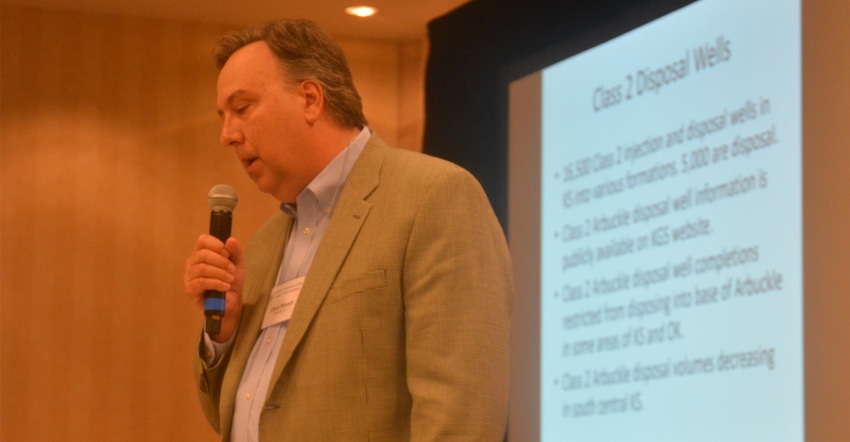
The Kansas Geological Survey would like to know a little more about the Arbuckle Formation, the prolific oil-producing formation that is the deepest rock layer underlying much of Kansas.
In a panel presentation at the Governor’s Conference on the Future of Water in Kansas, Rex Buchanan, director emeritus of the Kansas Geological Survey, said that 30 years ago, geologists thought of the Arbuckle as a nearly endless space for the disposal of brine generated by the production of oil and gas, especially because much of the oil production came from the formation.
He said the formation is also a source of fresh water for the Cherokee Basin in southeast Kansas and northeast Oklahoma, but multiple layers of shale separate the regions so there is no danger that water injected into the oil formation will migrate to the freshwater resource, making the Arbuckle an ideal disposal formation.
In more recent years, fracking and horizontal drilling, especially into the Mississippi Lime formation, has become widespread, and the disposal of huge amounts of generated brine into the formation has raised questions as regional seismic activity has exploded.
“Unlike traditional production where the wastewater and the oil are both extracted from the Arbuckle with disposal fluids injected back into the formation, the oil and produced water were being taken out of the Mississippian formation, then injected back into the Arbuckle,” Buchanan said. “That is a different dynamic.”
Now, Buchanan said, there are some signs that the Arbuckle is “filling up” in parts of the state, creating increasing concerns about contamination, including from artesian flows.
“There’s a lot we don’t know about the Arbuckle and the water chemistry in different zones, the fluid levels and pressures. There is so much variability and we’d like to know more about the movement of water within it,” Buchanan said.
Dave Newell, who represented KGS on the panel, explained that there are two kinds of disposal wells that inject wastewater into the Arbuckle. There are 49 Class 1 wells that are used for injection of industrial wastewater from manufacturing or chemical processing. The rest of the disposal wells are Class II wells that are used to inject the brine created as a result of producing oil and natural gas. The Kansas Department of Health and Environment supervises Class I wells while the Kansas Corporation Commission supervises Class II wells.
“Along with induced seismic activity, the danger of fresh water contamination increases,” Newell said. “How many years would it take for that to occur? If it does, we could lose our disposal wells but increasing static fluid levels could push saltwater into shallow aquifers like the Equus Beds in central Kansas. This is what makes us want to know more about the Arbuckle. We would like to get a few more wells to do fault-mapping and try to know more. What we are looking for is sustainability, both for disposal wells and for freshwater supplies.”
One city’s story
Brian Clennan, director of public works for the city of Hutchinson, said that Hutchinson owns two Class 1 wells for the disposal of water pumped from a pool groundwater contaminated by carbon tetrachloride than underlies about 1,200 acres of land. He said the cleanup will take several more years and involves pumping the water out, stripping it of contaminants pumping wastewater into the disposal wells.
He said the city is concerned that the approximately 1.3 million gallons per day of wastewater — both from the clean-up and from private companies that have permits to discharge their wastewater to the wells — will eventually cause problems, including induced seismicity. For that reason, the city is looking at ways to reduce the volume of wastewater, in part by seeking increased efficiency of the reverse osmosis process that is used to remove the contamination and naturally occurring chlorides to make some of the water useable.
A second option, he said, is to blend the chloride-laden water with treated water from the city’s wastewater treatment plant to a level that it meets quality parameters to be discharged into the river.
The oil industry view
Dana Wreath, vice president of Berexco LLC, said his company uses Arbuckle disposal wells for injection of produced water from oil wells in Kansas, Oklahoma and Nebraska.
He said KDHE pressure data shows that bottom of hole pressures in Class 1 wells is increasing but the Class II wells in the Arbuckle are not a problem. In fact, he said a monitoring well near Wellington shows that pressure is leveling off.
“We aren’t worried at all about capacity for produced oil and gas water in the Arbuckle,” he said. “There have been billions of gallons of oil removed from the Arbuckle and there is less going back in than has already come out.”
In Oklahoma however, almost all disposal wells are Class II wells and induced seismicity has been a big problem.
Wreath suggested that is because the water being disposed of is coming not from the Arbuckle, but from large volume production from the Mississippi Lime formation. He said Oklahoma and Kansas have supported regulations to reduce the volumes at wells where there have been earthquake issues.
Rick Miller, with the Kansas Geological Survey, said there is no way to assign blame for an earthquake to any one well. He said induced seismicity is a cumulative problem that comes from a collection of wells and formation variations.
Newell agreed. He said more study is needed.
“We do want to study this. We need to learn more precisely where disposal water is going and how it moves,” he said. “Fortunately, there’s not a crisis at this point. We are seeing very modest pressure increases. But we do want to participate in studies that tell us more about how water moves in the Arbuckle.”
About the Author(s)
You May Also Like






